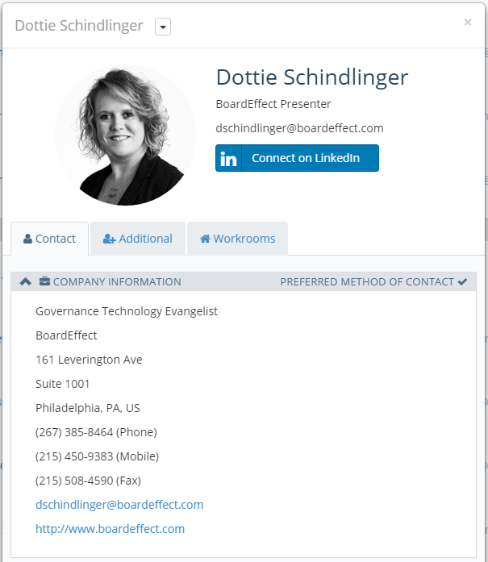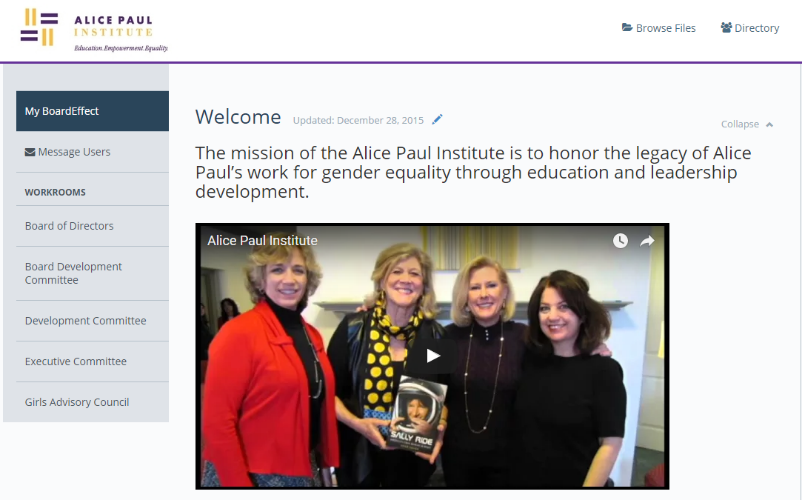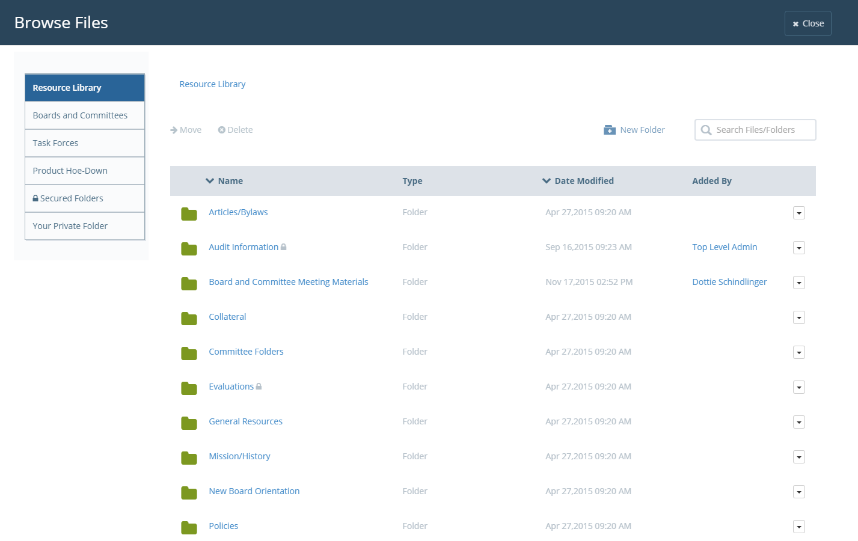How to Use a Board Portal to Hold the Greatest Board Meeting. Ever.
Recently, I had the pleasure of attending a workshop presented by Susan Howlett, a private nonprofit consultant based in Seattle, where she summarized the main points raised in her book, “Boards on Fire! Inspiring Leaders to Raise Money Joyfully.” One strategy Susan suggested was how to design the agenda of what I have since come to think of the Greatest Board Meeting – Ever. In other words, she answered the question, “How might you facilitate board meetings in such a way that directors are willing to cut their vacations short to attend?” Susan’s template for great board meetings could be adapted for just about any kind of board and in almost any organizational context – nonprofit, for-profit, large, small, traditional, or progressive. The focus is on “creating board meetings that elicit strategic leadership,” and her formula is simple, practical, and actionable – it doesn’t require a retreat to implement, nor a special task force committee to spearhead it – you could just start using it at your next meeting.
Over the weeks since I attended her session (and have since purchased copies of her book for all the members of the board I serve on), one thought has stayed with me – not only is her strategy a sound one, but it’s striking how well board portal software like BoardEffect can align with her strategy to extend the reach of a single terrific meeting, to an ongoing amazing experience for board members.
So, with major kudos to Susan for her keen and practical insights, I’m pleased to share her suggested formula for the Greatest Board Meeting Agenda Ever, along with my take on how board portal software could support and enhance the process.
AGENDA FOR A GREAT BOARD MEETING (about 90 minutes long)
5 Minutes: Community-building activity (involving food)
Susan has a brilliant blog post on the importance of board members “breaking bread” together as a way to build collegiality, trust, and familiarity. The more time we take as a group to get to know one another, the better we will be at having honest dialog, supportive collaboration, and productive group problem-solving. Including a short “get to know you” activity at the start of each meeting can also help us ensure we are all fully “present” at the meeting. Beyond what happens during the face-to-face meeting, board portal software platform like BoardEffect can extend community building efforts into an ongoing process. For example: using the Directory to include custom fields that highlight board members’ areas of expertise and experience; encouraging board members to link their LinkedIn profiles to their BoardEffect profile; and using the Discussion tool to engage members on topics of mutual interest – all are strategies that help members build trust and camaraderie, which matters when they have to work together to solve problems.

2-3 Minutes: Mission & inspiration
Susan recommends providing a moment at the start of the meeting to reconnect the board with the organization’s mission. For example, ask a staff member, stakeholder, or a board member relate a story of how the organization made a difference. You can even assign each board member a job to collect and tell a story at each board meeting – rotating through the board so everyone gets a turn. The more moving, pivotal, and relatable the stories are, the longer board members will remember them and the more frequently they will repeat the stories to others. Likewise, your board portal software can be used to extend and amplify story-telling efforts by facilitating the sharing of video, audio, links to websites, and other tangible examples of the organization engaged in its mission – making the stories more accessible for “sharing” by board members who want to post links to these examples on their own social media feeds and spread the word to their networks. By including mission stories at the start of our board meetings, we’re providing material that reconnects board members to the reason they got involved in the first place, and we’re handing them material they can use in their role as ambassadors.

1-2 Minutes: Consent Agenda Approval
Like Susan, I’m a big fan of consent agendas, particularly when they are used appropriately. The Consent Agenda allows the board to short-cut the often tedious process of individually approving routine business – such as the approval of minutes, acceptance of committee reports, routine financial reports, and the like – with a single vote. Anything that a board member would prefer to discuss before approving comes off the Consent Agenda and is added to the Discussion Items for review before approval. Otherwise, the assumption is that all board members have reviewed the contents of the Consent Agenda in advance, and can comfortably cast one vote approving all the routine items. Even simpler, providing the full Consent Agenda attached to an online vote in your board portal software – a “Poll” in BoardEffect, for example – allows the board members the time to review the consent items in advance and provide instant feedback on whether they are comfortable approving all of the items included.
This process can save time from the agenda for the good stuff listed below. (If you’re not familiar with consent agendas, check out this handy primer written by Terrie Temkin of CoreStrategies for Nonprofits, available on Susan Howlett’s site.)
15-20 Minutes: Board Education or Training
Provide an opportunity at every meeting for the board to get smarter on some topic – particularly those that will be important to the decisions they will need to make in the near future; and/or, provide some training that will help board members become more effective in their roles. I think we often lack creativity when we think of board training – there are the standard “Board Member 101” and “New Member Orientation” programs that many organizations provide for their boards. But the problem with this approach is that it’s often considered a one-time event, and in the span of 1-3 hours board members are expected to become experts on the topic. We all know that adults learn over time, and learn best when they can quickly apply new concepts to their own work. I would add that boards would be well-served to take a “lifelong learning” approach to their work. Even if someone has served on the same board for many years, we do not live in a static world – there are always things we could and should learn more about in order to stay sharp and be out most effective.
In this sense, board portal software can become a game changer. Too often, we think of board portal software as a place to “store stuff,” rather than leveraging the system as the learning tool it truly can be. Think of how much it could enhance your next board meeting if each board member was given a research topic in advance and required to collect information – including data from your organization as well as from the broader environment – and all of the intel they gather was organized and presented instantly through your board portal software. Not only would they feel more ownership over what happens in the resulting meeting, but they would have helped to create a knowledgebase for the board – one that could continually be expanded and referenced as important decisions have to be made.

60 Minutes: Governing
Let’s face it, the main reason your board members are serving on your board is because they want to add value – they want to spend their time doing something worthwhile. Nobody joins a board because they love listening to reports – even the best-written, most capably-presented reports can fail to engage the board if it doesn’t provide the board the opportunity to govern. Susan’s advice is to take a page from “Governance as Leadership” – the seminal work of Richard Chait, Barbara Taylor and Bill Ryan first introduced about a decade ago. Making the time in every meeting to work through a deep issue – one that requires board members to think creatively – will not only lead to happier, more productive board members, but will produce better results for the organization. Susan provides a set of sample “generative” questions to get the board going – but in my experience, a simple way to get started is simply to ask the organization’s CEO to share what keeps her/him awake at night, and get the board to frame the issues involved.
This can be particularly effective if the CEO’s thoughts are shared with the board in advance through a Survey set up in your board portal software. I want to give a special shout-out to BoardEffect’s CEO , Todd Gibby , for instituting this particular practice with our own board. In advance of each meeting, he polls our board for their responses to the proposed agenda, asking them:
- Which of these topics do you think we should spend the most time discussing at the next board meeting? What’s the right priority order for these topics?
- How much/what type of data would you like to have in advance of the discussion?
- Would any of these topics be dealt with better in a written report, rather than a board discussion?
- What topics (if any) do you feel we should add or remove from the next meeting agenda?
Once you have the feedback collected, it becomes a much simpler task to prepare the desired data and reports, combine them into a nice digital package and deliver that through your board portal platform in advance of the meeting. Just imagine how amazing your board meetings could be if board members arrive fully prepared to spend a full hour engaged in framing critical issues and problem-solving. By engaging the board in deciding what should be on the next meeting agenda, and then providing the very information they’ve requested prior to the meeting, directors are more likely to be fully “tuned in” and ready to make creative, insightful decisions.
Dottie Schindlinger is Executive Director of the Diligent Institute, the governance think tank and research arm of Diligent Corporation. In her role, Dottie promotes the intersection of governance and technology as a recognized expert in the field. She co-authored Governance in the Digital Age: A Guide for the Modern Corporate Board Director,©2019, John Wiley & Sons Publishers, and is creator and co-host of The Corporate Director Podcast, a fortnightly show featuring corporate directors sharing their stories about modern governance.
PREVIOUS POST :
Why Board Development is More of a Process than an Event